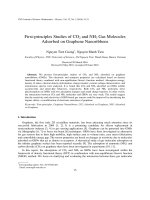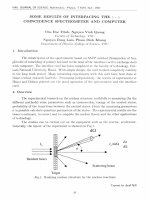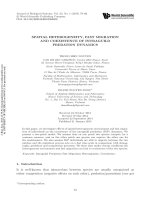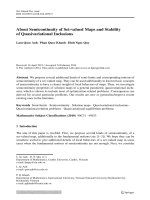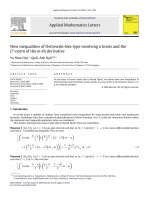DSpace at VNU: First-principles Studies of CO2 and NH3 Gas Molecules Adsorbed on Graphene Nanoribbons
Bạn đang xem bản rút gọn của tài liệu. Xem và tải ngay bản đầy đủ của tài liệu tại đây (1.14 MB, 7 trang )
VNU Journal of Science: Mathematics – Physics, Vol. 32, No. 2 (2016) 15-21
First-principles Studies of CO2 and NH3 Gas Molecules
Adsorbed on Graphene Nanoribbons
Nguyen Tien Cuong*, Nguyen Manh Tien
Faculty of Physics, VNU University of Science, 334 Nguyen Trai, Thanh Xuan, Hanoi, Vietnam
Received 20 March 2016
Revised 16 May 2016; Accepted 26 June 2016
Abstract: We present first-principles studies of CO2 and NH3 adsorbed on graphene
nanoribbons (GNRs). The electronic and transport properties are calculated based on density
functional theory combined with non-equilibrium Green's function method. Absorption energy,
density of states, electron density deformation, charge transfer, current-voltage characteristics, and
transmission spectra were analyzed. It is found that CO2 and NH3 adsorbed on GNRs exhibit
acceptor-like and donor-like behaviors, respectively. Both CO2 and NH3 molecules show
physissorption on GNRs with low adsorption energies and small charge transfers. In other words,
the interactions between CO2 and NH3 molecules and GRNs are very weak. The results suggest
that the sensitivity and selectivity of GRN-based gas sensors could be improved by introducing the
dopant, defect, or modification of electronic structures of graphene.
Keywords: First-principles, Graphene Nanoribbons, CO2 Adsorbed on Graphene, NH3 Adsorbed
on Graphene.
1. Introduction∗
Graphene, the first truly 2D crystalline materials, has been attracting much attention since its
successful fabrication in 2004 [1, 2]. It is a promising candidate for silicon replacement in
semiconductor industry [3, 4] or gas sensing applications [5]. Graphene can be patterned into GNRs
via lithographic [6, 7] or focus ion beam [8] techniques. GRNs have been investigated as alternative
for gas sensors due to their high mobility, high surface area to volume ratio, easy micro fabrication,
and controllable energy gap. The sensor properties are based on changes in resistivity due to molecules
adsorbed on GRNs that act as donors or acceptors. A theoretical study of gas molecular adsorption on
the infinite graphene surface has been reported recently [9]. The adsorption of ammonia (NH3) and
carbon dioxide (CO2) on graphene sheet have been investigated in experiments [10, 11].
In this report, the adsorptions of CO2 and NH3 on GRNs have been investigated within the
framework of density functional theory (DFT) in combination with non-equilibrium Green's function
(NEGF) method. We focus on clarifying and evaluating the interaction between these gas molecules
_______
∗
Corresponding author. Tel.: 84-973041481
Email:
15
16
N.T. Cuong, N.M. Tien / VNU Journal of Science: Mathematics – Physics, Vol. 32, No. 2 (2016) 15-21
and GNRs. The study also contributes for understanding the atomistic mechanism of gas molecules
adsorbed on GNRs to assist designing gas graphene-based sensors.
2. Model and computational method
First-principles calculations are performed to study the adsorption of CO2 and NH3 gas molecules
on GNRs. The electronic and transport properties are calculated using the combination of DFT and
NEGF methods. In particular, the electronic properties such as density of state (DOS), electron
density, and charge transfer analysis are calculated based on DFT using Materials Studio/Dmol3
package [12]. The transmission spectra, current-voltage characteristics are calculated based on NEGF
method which is implemented in the OpenMX package [13]. All calculations were carried out within
the generalized gradient approximation of Perdew-Burke-Ernzerhof (GGA-PBE) exchange-correlation
functional [14]. The SCF energy convergence criterion is set to 10−6 Hartree. In the treatment of
pseudo-potentials, the pseudo atomic orbital basis sets of C4.5-s2p1 for carbon and H4.5-s2 for
hydrogen were used, where in the abbreviation of basis functions such as C4.5-s2p1, C stands for the
atomic symbol, 4.5 the cutoff radius (bohr) in the generation by the confinement scheme, and s2p1
means the employment of two primitive orbitals for s and one primitive orbital for p [13]. These basis
sets was chosen based on the optimized parameters calculations.
Figure 1. (a) Configuration of the system treated by NEGF method. (b) One dimensional system derived
from the configuration of (a) where the region C is an extended central region consisting of L0, C0, and R0.
(c) Structure model of GNRs with CO2 and NH3 gas molecules adsorption.
For quantum transport calculations in OpenMX, a system consisting of a central region connected
to left and right leads with infinite size, as shown in Fig. 1a, is treated by the NEGF method. By
considering the two dimensional periodicity in the bc-plane, the system can be cast into a onedimensional problem, as show in Fig. 1b. The electronic transport is assumed to occur along the aaxis. The structure model of CO2 and NH3 gas molecules adsorbed on the center of 10-AGRN (Fig.
1c) and 9-ZGNR were used. In the model, the edges of GNRs were terminated by hydrogen to avoid
effect of edge dangling bonds.
N.T. Cuong, N.M. Tien / VNU Journal of Science: Mathematics – Physics, Vol. 32, No. 2 (2016) 15-21
17
3. Results and discussion
3.1. Geometry optimization and adsorption energy
The previous DFT calculation study of CO2 adsorbed on Armchair GNRs (AGNRs) shows that the
C-C and C-O distances are 1.51 Å and 1.26Å, respectively, and the C-O-C angle is 127o [15].
Therefore, the similar structure was used for initial configuration (Fig. 2a). For the adsorption of NH3
on AGNR, the initial structure was built as show in Fig. 2c, in which adsorbed NH3 molecule sits
1.49Å away from AGNR sheet, the H-N distance is 1.03Å, and the dihedral angle is about 21o between
the C-N bond and the AGNR plane [15]. The optimized structures are show in the Fig. 2b and 2d. One
can see that both CO2 and NH3 molecules go far away from AGNRs in comparison with initial
structures. In particular, the distance between CO2, NH3 molecules and the AGNR sheet are 2.82Å,
2.80Å, respectively.
Figure 2. (a), (c) initial structures; and (b), (d) optimized structures of
AGNR adsorbed CO2 and NH3, respectively.
For Zigzag GNRs (ZGNRs) adsorption cases, the initial structures are built by putting a relax CO2
(NH3) molecule on the ZGNRs sheet with distance of 1.5Å as show in the Fig. 3a and 3c. Similarly to
the AGNR adsorption cases, the optimized structures show that the adsorbed molecules tend to go far
away from the ZGNR sheets. The distance between CO2 and NH3 molecules and the ZGNR sheet are
2.86Å and 3.05Å, respectively.
Figure 3. (a), (c) initial structures, and (b), (d) optimized structures of
ZGNR adsorbed CO2 and NH3, respectively.
18
N.T. Cuong, N.M. Tien / VNU Journal of Science: Mathematics – Physics, Vol. 32, No. 2 (2016) 15-21
Adsorption energy (∆Eads) is a key quantity in predicting adhesive property of an adsorption
system. As is known, the adsorption energy is defined as
(1)
Where EGNR_Gas is the total energy of the GNR with gas molecule adsorption. EGNR, EGas are the
energies of isolated GNR and isolated corresponding gas molecule, respectively. In general, a negative
∆Eads indicates that the molecule adsorption is exothermic and thus the adsorption system is
energetically stable.
Table 1. Adsorption energies (eV) of CO2 and NH3 on GNRs
AGNR
ZGNR
CO2
-0.186
-0.157
NH3
-0.153
-0.175
The adsorption energies of CO2 and NH3 molecules on GNRs are shown in the Table 1. We can
see that all adsorption energies are negative with absolute smaller than 0.5eV per molecule in both
AGNR and ZGNR cases. It implies that the interaction between these adsorbed gas molecules and
GNRs are physisorption. In the other words, these interactions are very weak.
Figure 4. (a), (c) side view and (b),(d) cross-section view of electron density deformation of AGNR with CO2
and NH3 adsorptions, respectively, at the iso-value of 0.001 a.u.
N.T. Cuong, N.M. Tien / VNU Journal of Science: Mathematics – Physics, Vol. 32, No. 2 (2016) 15-21
19
3.2. Electron density deformation and charge transfer
In order to clarify the electronic interaction between adsorbed gas molecule and GNRs, electron
density deformations have been analyzed. The electron density deformation is defined as the
difference between the electron densities of GNR adsorbed gas molecule and sum of the electron
densities of isolated GNR and of isolated gas molecule
(2)
Where ρGNR_Gas is electron density of GNR with gas molecule adsorption. ρGNR, ρGas are the electron
densities of isolated GNR and isolated corresponding gas molecule, respectively. Fig. 4 shows the
electron density deformation of AGNR with CO2 and NH3 adsorptions. The red electron density
deformation has positive value and blue one has negative value. It implies that there is an amount of
electrons transferred from AGNR to CO2. In opposite, electrons are transferred from NH3 to AGNR.
Our electron density deformation calculations for ZGRN with CO2 and NH3 adsorptions show
similar results.
In order to understand the charge transfer quantity, Mulliken populations have been examined. It is
found that there is small amount of 0.00868e (0.0843e) charge transferred from AGNR (ZGNR) to
CO2 molecule. It indicates that CO2 adsorbed on GNRs acts as an acceptor-like (p-type). In contrast,
there is a small amount of 0.08838e (0.08997e) charge transferred from NH3 molecule to AGNR
(ZGNR). In other works, NH3 adsorbed on GNRs will act as a donor-like (n-type). These results are in
good agreement with previous study [9]
3.3. Density of states, transmission spectra, and current-voltage characteristics
Figure 5. (a), (b) DOS (eV-1) and (c), (d) corresponding transmission spectra of AGNRs with CO2, and NH3
adsorptions, respectively (green lines), in comparison to AGNRs without adsorption (red lines).
20
N.T. Cuong, N.M. Tien / VNU Journal of Science: Mathematics – Physics, Vol. 32, No. 2 (2016) 15-21
Figure 5 shows the DOS and corresponding transmission spectra of AGNR within CO2 and NH3
adsorptions in comparison to AGNR without adsorption.
In the case of AGNR without adsorption, we can see that DOS shows multiple sharp peaks which
are caused by lateral quantization of electronic states in the one-dimensional AGNRs. Therefore, the
corresponding transmission spectrum has a step-shape.
Figure 6. Current-voltage characteristics for AGNR sensor without and with adsorptions of CO2 and NH3. The
inset shows the schematics of such a AGRN sensor.
In the case of AGNR with CO2 adsorption, the DOS are almost unchanged in comparison to
AGNR without adsorption because of very weak interaction between CO2 molecule and ANGR. This
caused transmission spectra almost unchanged. However, these transport features are slightly changed
with the presence of an adsorbed NH3 molecule. Sharp peaks at the lowest unoccupied molecular
orbital (LUMO) energy cannot be seen in DOS, and the transmission rate is reduced near the LUMO
edge. The changes of transmission spectra effect on their current-voltage characteristics, which are
shown in the Fig. 6. This demonstrated that GRNs can be used as a gas sensor to detect CO2 and NH3.
However, the sensitivity and selectivity of the GRN-based sensors are low due to the weak interaction
between GRN and these adsorbed gas molecules.
4. Conclusion
First-principles calculations were performed to study the adsorption of CO2 and NH3 gas
molecules on GNRs. The analysis of electron deformation densities and charge transfers demonstrates
that CO2 and NH3 adsorbed on GNRs exhibit acceptor-like and donor-like behavior, respectively. The
obtained results show that both CO2 and NH3 gas molecules show physisorption on GNRs with low
adsorption energies and small charge transfer. It implied that the interaction between CO2 and GNRs
are very weak. The results suggest that the sensitivity and selectivity of graphene-based gas sensors
could be improved by introducing the dopant, defect, or modification of electronic structure of
graphene.
N.T. Cuong, N.M. Tien / VNU Journal of Science: Mathematics – Physics, Vol. 32, No. 2 (2016) 15-21
21
Acknowledgments
The authors thank the VNU University of Science for funding this work within project No. TN.1505. The computations presented in this study was performed at the Department of Computational
Physics, Faculty of Physics of VNU University of Science, Vietnam, and the Information Center of
Japan Advanced Institute of Science and Technology, Japan.
References
[1] K. S. Novoselov, A. K. Geim, S. V. Morozov, D. Jiang, Y. Zhang, S. V. Dubonos, I. V. Grigorieva, and A. A.
Firsov, “Electric Field Effect in Atomically Thin Carbon Films”, Science 306, (2004) 666-669
[2] K. S. Novoselov, A. K. Geim, S. V. Morozov, D. Jiang, M. I. Katsnelson, I. V. Grigorieva, S. V. Dubonos, and
A. A. Firsov, “Two-Dimensional Gas of Massless Dirac Fermions in Graphene”, Nature 438, (2005) 197-200
[3] S. V. Morozov, K. S. Novoselov, M. I. Katsnelson, F. Schedin, D. C. Elias, J. A. Jaszczak, and A. K. Geim,
“Giant Intrinsic Carrier Mobilities in Graphene and Its Bilayer”, Phys. Rev. Lett. 100, (2008) 016602
[4] A. K. Geim, and S. V. Morozov, “The Rise of Graphene”, Nature Materials 6, (2007) 183-191
[5] F. Schedin, A. K. Geim, S. V. Morozov, E. W. Hill, P. Blake, M. I. Katsnelson, and K. S. Novoselov, “Detection
of individual gas molecules adsorbed on graphene”, Nature Materials 6, (2007) 652-655
[6] C. Berger, Z. Song, X. Li, X. Wu, N. Brown, C. Naud, D. Mayou, T. Ji, J. Hass, A. N. Marchenkov, E. H.
Conrad, P. N. First, W. A. de Heer, “Electronic Confinement and Coherence in Patterned Epitaxial Graphene”,
Science 312, (2006) 1191-1196
[7] Melinda Y. Han, Barbaros Ozyilmaz, Yuanbo Zhang, and Philip Kim, “Energy Band-Gap Engineering of
Graphene Nanoribbons” ,Phys. Rev. Lett. 98, (2007) 206805
[8] Nima Kalhor, Stuart A. Boden, and Hiroshi Mizuta, “Sub-10 nm patterning by focused He-ion beam milling for
fabrication of downscaled graphene nano devices”, Microelectronic Engineering 114 (2014) 70-77
[9] O. Leenaerts, B. Partoens, and F. M. Peeters, “Adsorption of H2O, NH3, CO, NO2, and NO on graphene: A firstprinciples study”, Phys. Rev. Lett. 77, (2008) 125416
[10] H. E. Romero, P, Joshi, A. K. Gupta, H.R. Gutierrez, M. W. Cole, S. A. Tadigadapa, P. C. Eklund, “Adsorption
of ammonia on graphene”, Nanotechnology 20, (2009) 245501-245509.
[11] A. K. Mishra and S. Ramaprabhu, “Carbon dioxide adsorption in graphene sheets”, AIP Advances 1, (2011)
032152
[12] />[13] />[14] J. P. Perdew, K. Burke, and M. Ernzerhof, “Generalized Gradient Approximation Made Simple”, Phys. Rev. Lett.
77, (1996) 3865
[15] B. Huang,Z. Li, Z. Liu, G. Zhou,S. Hao,J. Wu,B.-L. Gu, and W. Duan, “Adsorption of Gas Molecules on
Graphene Nanoribbons and Its Implication for Nanoscale Molecule Sensor”, J. Phys. Chem. C. 112 (2008)
13442-13446



